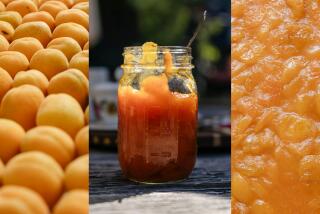Fruit in a Stew
- Share via
Spotting ripe, sweet fruit at the market isn’t easy, particularly since many fruits are harvested before they reach their peak of ripeness; otherwise, they wouldn’t survive the process of getting to the consumer. Most fruits picked before they are ripe--especially stone fruits like nectarines, peaches, apricots and plums--don’t develop more sweetness after harvest.
They will ripen in color, texture and juiciness, however. Carlos Crisosto, a post-harvest physiologist with the Kearney Agricultural Center at UC Davis, says that once a stone fruit is harvested, its sugar content does not increase; it remains constant. But the acid level drops away, providing a better sugar-acid balance and consequently a sensation of more sweetness on the palate.
Other fruits that behave this way are blueberries, cantaloupes, casabas, crenshaws, figs, honeydews and persimmons.
Some fruits--including apples, kiwis, mangoes, papayas, pears, bananas and avocados--do get sweeter after they are picked. Then there are the fruits that don’t change at all after harvest: blackberries, cherries, grapes, grapefruits, lemons, limes, oranges, pineapples, raspberries, strawberries and watermelons.
When I buy stone fruit that is not ready to eat or cook, I put the fruit in a brown paper bag in a dark cupboard for a couple of days to hasten the softening process.
COUNTRY CASSEROLE OF APRICOTS AND PLUMS
This French country dessert comes from a wonderful cook, Claudia Roden. Top each serving with vanilla ice cream or whipping cream if desired.
8 large apricots, halved and pitted
6 large plums, halved and pitted
2/3 cup sugar plus 6 tablespoons
2/3 cup water
1 1/2 cups whole unblanched almonds
Put apricots and plums in large skillet. Mix 2/3 cup sugar and water and pour into skillet. Cover and simmer over low heat until fruit is tender when pierced with fork, 5 to 7 minutes, being careful not to overcook. Set aside.
Process almonds and remaining 6 tablespoons sugar in food processor until mixture is fine, but not paste. Spread mixture evenly in 10-inch round baking dish.
Arrange fruit, cut side down, over almond mixture. Pour 2/3 cup fruit juices remaining in skillet over fruit and almonds. Bake at 325 degrees 1 hour. Taste fruit for sweetness; if necessary, sprinkle more sugar on top while hot. Serve warm.
6 servings. Each serving:
406 calories; 5 mg sodium; 0 cholesterol; 19 grams fat; 57 grams carbohydrates; 8 grams protein; 1.68 grams fiber.
BAKED BANANAS
1/4 cup (1/2 stick) butter
1 teaspoon grated lemon peel
1 tablespoon lemon juice
4 firm ripe bananas
1/4 cup dark brown sugar, packed
Vanilla ice cream, optional
Combine butter, lemon peel and juice in baking dish and place in 350-degree oven just long enough to melt butter, 2 to 3 minutes. Remove and stir.
Peel bananas and put in baking dish, turning to coat with butter mixture. Sprinkle with brown sugar and bake at 350 degrees 15 minutes. Serve with vanilla ice cream if desired.
4 servings. Each serving, without ice cream:
259 calories; 122 mg sodium; 31 mg cholesterol; 12 grams fat; 40 grams carbohydrates; 1 gram protein; 0.57 gram fiber.


